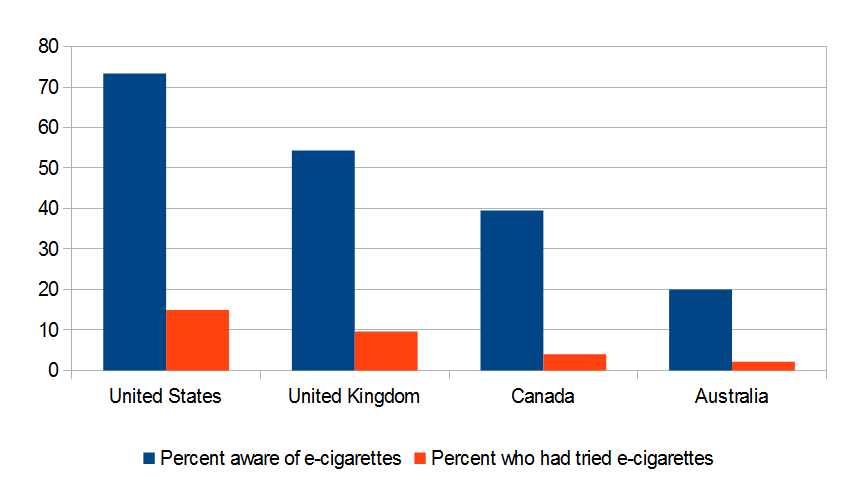Electronic cigarettes (i.e., e-cigarettes) are devices in which solution containing nicotine is atomized by a heating coil and then inhaled. These e-cigarettes, mentioned in ASHES, Vol. 9(4), are a relatively new addition to the nicotine product landscape. Since entering the market less than ten years ago, they have faced increased scrutiny from policymakers (e.g., DeLancey, 2010), including outright bans in Canada (Health Canada, 2009) and Australia (Australian Government Therapeutic Goods Administration, 2013) due to questionable health and safety evidence. This week’s ASHES reviews a study that measured the awareness, attitudes and usage of e-cigarettes in four industrialized nations (Adkison et al., 2013).
Image courtesy of Wikipedia. Click image to enlarge.
Methods
- Researchers analyzed data from Wave 8 of the International Tobacco Control Four-Country Survey, occurring between July 2010 and June 2011 (Thompson et al., 2006).
- Respondents were from the U.S. (n = 1520), the U.K. (n = 1325), Canada (n=1581), and Australia (n = 1513).
- At enrollment, respondents included in the current study (1) were 18 years old or older, (2) had smoked at least 100 cigarettes over their lifetime and (3) smoked at least one cigarette in the 30 days before enrollment[1].
- This survey asked respondents if they had heard of e-cigarettes, whether they had tried an e-cigarette themselves in the past, and whether they were current users.
- The survey also asked those who were aware of e-cigarettes whether they thought that e-cigarettes were more harmful than traditional cigarettes, equally as harmful as traditional cigarettes, or less harmful than traditional cigarettes.
Results
- As shown in Figure 1, larger percentages of respondents had heard of e-cigarettes in the countries where sales were legal (the U.S and the U.K.) than in the countries where e-cigarettes were banned (Canada and Australia).
- Roughly one out of every six respondents who were aware of e-cigarettes had tried one.
- Despite the bans, 10% of Canadians and 11% of Australians who were aware of e-cigarettes reported having tried one.
- Across countries, roughly 70% of those who were aware of e-cigarettes believed that they were less harmful than traditional cigarettes. This varied somewhat by country; respondents in the UK were most likely to view e-cigarettes as less harmful than traditional cigarettes (82%), while those in the US were least likely to hold this view (66%).

Figure. Percentages of respondents who were aware of e-cigarettes and had used e-cigarettes by country. Click image to enlarge.
Limitations
- The study only surveyed current and former smokers, so the results are not necessarily indicative of the awareness and beliefs of overall populations.
- Data on awareness may be out of date, since there have been changes in the advertisement and distribution of e-cigarettes since the time of the study. For example, last December the first ads appeared on television in the U.S. (Sanburn, 2013).
Conclusion
Larger percentages of smokers know about e-cigarettes in the countries where e-cigarettes are legal, presumably due to differences in marketing efforts. For example, in the U.S., smokers are exposed to ads via magazines and on television. Despite a lack of solid evidence, a substantial number of people believe that e-cigarettes are less harmful than traditional cigarettes. Even in the two countries where they were banned, nontrivial percentages of people reported trying or using e-cigarettes. Through internet sales and other means, consumers are finding ways around the restrictions. Researchers should conduct more studies and clinical trials to determine if e-cigarettes are truly less harmful, if they can actually help people quit, and if so, how they can be used as part of smoking cessation programs.
– Matthew Tom
References
Adkison, S. E., O’Connor, R. J., Bansal-Travers, M., Hyland, A., Borland, R., Yong, H.-H., … Fong, G. T. (2013). Electronic Nicotine Delivery Systems. American Journal of Preventive Medicine, 44(3), 207–215. doi:10.1016/j.amepre.2012.10.018
Australian Government Therapeutic Goods Administration. (2013, March 12). Electronic cigarettes. Australian Government Department of Health and Ageing. Retrieved from http://www.tga.gov.au/consumers/ecigarettes.htm
DeLancey, S. (2010, September 9). FDA acts against 5 electronic cigarette distributors. WebContent. Retrieved June 3, 2013, from http://www.fda.gov/NewsEvents/Newsroom/PressAnnouncements/2010/ucm225224.htm
Health Canada. (2009, March 4). To All Persons Interested in Importing, Advertising or Selling Electronic Smoking Products in Canada – Health Canada Notice 2009-03-27. notice. Retrieved June 11, 2013, from http://www.hc-sc.gc.ca/dhp-mps/prodpharma/applic-demande/pol/notice_avis_e-cig-eng.php
Sanburn, J. (2013, January 8). Can Electronic Cigarettes Challenge Big Tobacco? Time.com. Retrieved from http://business.time.com/2013/01/08/can-electronic-cigarettes-challenge-big-tobacco/#ixzz2VBdCiXPg
Thompson, M. E., Fong, G. T., Hammond, D., Boudreau, C., Driezen, P., Hyland, A., … Laux, F. L. (2006). Methods of the International Tobacco Control (ITC) Four Country Survey. Tobacco Control, 15(suppl_3), iii12–iii18. doi:10.1136/tc.2005.013870
What do you think? Please use the comment link below to provide feedback on this article.






Fr. Jack Kearney June 12, 2013
Yes, much more research needs to be done, but currently there is enough science out there to reasonably say that these are “truly” less harmful than tobacco cigarettes (try 99%), and are much more effective than NRTs in helping people quit smoking. I am doing some informal research in addiction treatment centers who allow ecigs, and we’re getting at least a 50% reduction in tobacco use. With at least 5 million smokers using these things you would think that the people with the money to fund more research would be jumping at the opportunity to save lives here, but it appears that the tobacco and pharmaceutical industries are getting in the way. Let’s advocate for more research here, but fighting ecigs in the meantime is like telling a drowning man not to get into a lifeboat because it might have a leak.